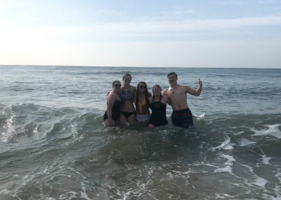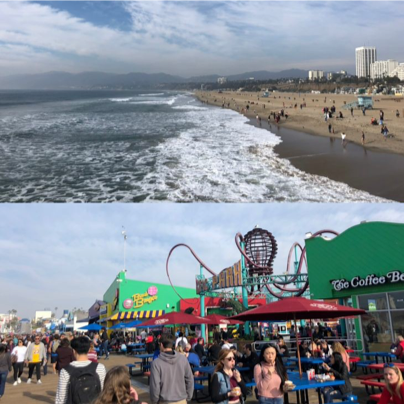by Gabi Coprivnicar, ’22
“Life’s a beach!” – Anonymous
Santa Monica, first established in 1875 [1], has grown into an exciting blend of vibrant colors, unique communities, and diverse cultures. Our day eight adventure, beginning with impressive van maneuvers through a parking garage and ending with a couple of aesthetic displays of liquid nitrogen, could not have been a better start to our second week in Los Angeles. Hi! I’m Gabi Coprivnicar, a Whitworth freshman studying Elementary Education.

Our first walk on the beach came with open mouths and joyful spirits as several Spokane dwellers approached the awe-inspiring Pacific Ocean. After a quick dip in (like we’re tourists or something) and some sunbathing, we made it up to Santa Monica Pier.
The pier, filled with lots of stimuli and lots of people, made me contemplate the interesting question of whether art is still art if its main goal is to make a profit.

My eyes were drawn to the vivid colors and designs of the attraction signs, then my focus was continuously deterred by a song from across the walk, the smell of a passing cart carrying sizzling hot dogs and bacon, or someone with an original CD trying to get my attention and support. All could arguably be art, but all are also for profit and at that moment I was wrestling with whether these stirring stimuli could possibly be put in the same category of what we’ve been seeing in structured and quiet museums for the past week.
After passing several very talented street performers, I got sucked into a magic show where the magician was doing a simple disappearing quarter trick. I’m easily entertained so this hooked me, but then he proceeded to have one of my classmates sign his name on a 20 dollar bill, threw that 20 in the ocean, and then somehow pulled the same signed bill out of a lemon he cut open in front of us. Yes, the trick was crazy and I still don’t understand it, but the real art came from the magician’s passion for his work and genuine care that we were enjoying ourselves. After a couple more personalized experiences like this, I felt like I was able to develop a deeper sense of the aspects of this pier that, at first, overwhelmed me. From the outside, big attractions, like the Santa Monica Pier, seem unpersonalized and uncaring, but looking a little closer into the different facets that make it what it is, like we had the opportunity to do, presents a more authentic picture of what this community is like.
After our time exploring the pier, we walked along the beach, passing little communities of slackliners, weightlifters, and skaters, on our way to the Venice Boardwalk. About a mile and a half long [2], the Venice Boardwalk is an energized, bustling district lined with all kinds of art from wood carvers to jugglers and everything in between. One display that really caught my attention was a band made up of about seven homeless men. Despite their situations, they were able to come together with what they had to make extremely entertaining music. The band looked very happy to be doing something they enjoyed for people who, for the most part, came there to see artistry like that.
One of my classmates had an insightful conversation with a seasoned Venice artist who talked about how the culture of this boardwalk had changed due to the legalization of marijuana.

The artist believed that the legalization and constant smoking allowed his community to become messier and overall less attractive to the kinds of people that would normally make up the Venice Boardwalk crowd. This not only changes the whole culture of the place but also decreases business for him and countless others who relied on a certain kind of customer. This is an unfortunate change in the economy and culture of a place that has so much potential, but I found this conversation extremely interesting. I realized that it’s not just the artists that make up Santa Monica’s and Venice’s unique culture, but also the tourists and the consumers who keep that community alive and running. Though I did feel a little crowded and lost during my time exploring this part of the town, insight like this displays the true heart of the community and it’s special, genuine intentions.
I think both the Santa Monica Pier and the Venice Boardwalk have so much to offer in the way of art, though this art would not go in the same category of what we’ve been seeing in museums. Seeing the artists next to their beloved handiwork inserts a sense of personality into the art that you’re not able to get in museums. These artists work hard at what they do so that we can enjoy our time in their community. I feel extremely grateful for this opportunity to see a culture like nothing I’ve seen before, where the arts are such an alive and important part of it. If you ever have the chance to explore this part of Los Angeles, I highly recommend!
We use cookies to improve your experience on our site. By using our site, you consent to cookies.
Websites store cookies to enhance functionality and personalise your experience. You can manage your preferences, but blocking some cookies may impact site performance and services.
Essential cookies enable basic functions and are necessary for the proper function of the website.
These cookies are needed for adding comments on this website.
Statistics cookies collect information anonymously. This information helps us understand how visitors use our website.
Google Analytics is a powerful tool that tracks and analyzes website traffic for informed marketing decisions.
Service URL: policies.google.com